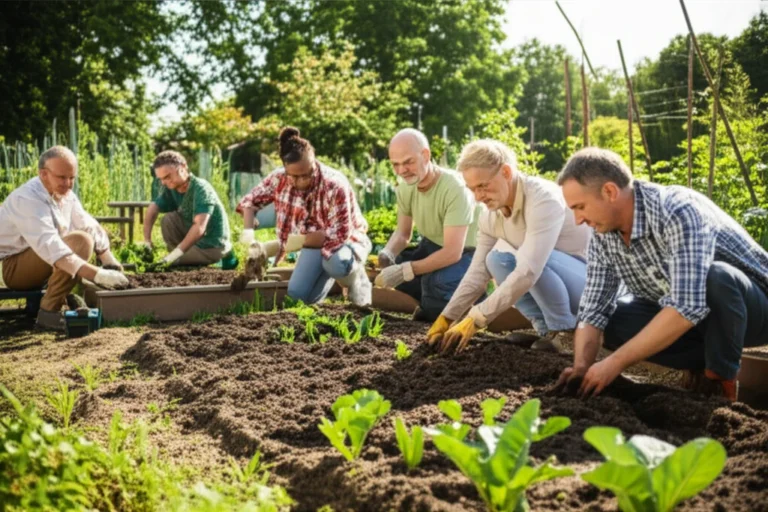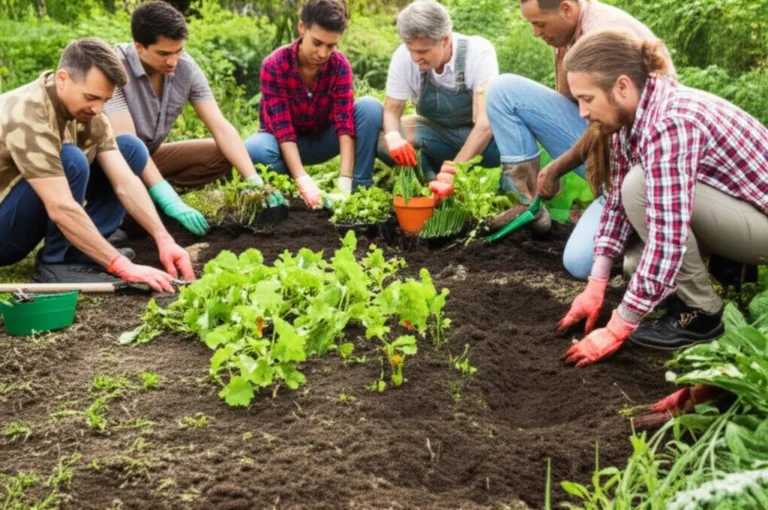Support our educational content for free when you purchase through links on our site. Learn more
Community gardens are sprouting up all over the globe, transforming urban landscapes and enriching lives in ways we often overlook. But what is the global impact of community gardens? From enhancing food security to fostering social connections, these green spaces are more than just patches of soil; they are vital ecosystems that contribute to healthier communities and a more sustainable planet. Did you know that community gardens can reduce urban heat by up to 5°F? 🌱 This article dives deep into the multifaceted benefits of community gardens, exploring how they serve as catalysts for change in cities worldwide.
As we navigate through the various dimensions of community gardens, you’ll discover not only their environmental and social significance but also practical insights on how to start your own garden. Whether you’re a seasoned gardener or just curious about the movement, there’s something here for everyone!
Key Takeaways
- Environmental Benefits: Community gardens help reduce carbon emissions and improve air quality.
- Social Cohesion: They foster community spirit by bringing diverse groups together.
- Food Security: Community gardens provide access to fresh produce, enhancing nutrition.
- Economic Impact: They can create jobs and stimulate local economies.
- Health Improvements: Gardening activities promote physical and mental well-being.
Ready to dig in? 👉 Shop gardening tools and supplies to kickstart your community garden journey today! 🌿 Shop Gardening Tools on Amazon | Shop Seeds and Plants on Amazon
Table of Contents
- Quick Tips and Facts
- The Global Significance of Community Gardens
- Historical Roots of Community Gardening
- Environmental Benefits of Community Gardens
- Social Impact: Building Community Through Gardening
- Economic Advantages of Community Gardens
- Health and Nutrition: The Garden-to-Table Movement
- Cultural Diversity and Community Gardens
- Challenges Facing Community Gardens Worldwide
- Successful Community Garden Models Around the Globe
- How to Start Your Own Community Garden
- Innovative Technologies in Community Gardening
- The Future of Community Gardens: Trends and Predictions
- Conclusion
- Recommended Links
- FAQ
- Reference Links
Quick Tips and Facts
To get started with understanding the global impact of community gardens, let’s first link to a related article about What is a Community Garden and How Does It Work? 🌱. Community gardens are not just plots of land where people grow their own fruits and vegetables; they are community hubs that bring people together, promote sustainability, and provide numerous health benefits. Here are some quick tips and facts about community gardens:
- They can be found in urban, suburban, and rural areas.
- Community gardens can help reduce stress, improve mental health, and increase social connections.
- They provide an opportunity for people to grow their own food, learn new skills, and connect with nature.
- Community gardens can also serve as community centers, hosting events and activities that bring people together.
Benefits of Community Gardens
For more information on the benefits of community gardens, visit our category on Benefits of Community Gardens. Some of the benefits of community gardens include:
- Improved physical health: Community gardens provide an opportunity for people to engage in physical activity, such as gardening and exercise.
- Improved mental health: Community gardens can help reduce stress, improve mood, and increase social connections.
- Increased food security: Community gardens provide an opportunity for people to grow their own food, increasing access to fresh, healthy produce.
The Global Significance of Community Gardens
Community gardens are not just a local phenomenon; they have a global significance. According to a study published on PubMed, community gardens can help mitigate the effects of climate change by providing green spaces that absorb carbon dioxide and produce oxygen. They can also help address food insecurity by providing an opportunity for people to grow their own food.
Global Impact of Community Gardens
The global impact of community gardens is significant. They can help:
- Reduce urban heat islands: Community gardens can provide shade, reduce temperature, and improve air quality in urban areas.
- Increase biodiversity: Community gardens can provide a habitat for plants and animals, increasing biodiversity in urban areas.
- Promote sustainable living: Community gardens can promote sustainable living by providing an opportunity for people to grow their own food, reduce waste, and conserve water.
Historical Roots of Community Gardening
Community gardening has a long history that dates back to the Victorian era. During this time, community gardens were established in urban areas to provide a green space for people to relax and enjoy nature. Today, community gardens can be found in many parts of the world, including the United States, Canada, Australia, and Europe. For more information on the history of community gardening, visit our category on Community Garden Events.
Evolution of Community Gardens
Over time, community gardens have evolved to meet the changing needs of communities. Today, community gardens are not just about growing food; they are also about building community, promoting sustainability, and providing education. Some community gardens have even incorporated innovative technologies, such as hydroponics and vertical gardening, to increase efficiency and productivity.
Environmental Benefits of Community Gardens
Community gardens have numerous environmental benefits. They can help:
- Reduce carbon emissions: Community gardens can provide a green space that absorbs carbon dioxide and produces oxygen.
- Increase biodiversity: Community gardens can provide a habitat for plants and animals, increasing biodiversity in urban areas.
- Improve air quality: Community gardens can help improve air quality by reducing pollution and increasing oxygen production.
Sustainable Gardening Practices
To learn more about sustainable gardening practices, visit our category on Garden Maintenance Tips. Some sustainable gardening practices include:
- Using rainwater: Community gardens can use rainwater to reduce water consumption and prevent stormwater runoff.
- Composting: Community gardens can compost food waste to reduce landfill waste and create nutrient-rich soil.
- Using natural pest control: Community gardens can use natural pest control methods, such as introducing beneficial insects, to reduce the use of chemical pesticides.
Social Impact: Building Community Through Gardening
Community gardens have a significant social impact. They can help:
- Build community: Community gardens can provide a space for people to come together, build relationships, and develop a sense of community.
- Promote social cohesion: Community gardens can help promote social cohesion by providing a space for people from different backgrounds to come together and share experiences.
- Provide education: Community gardens can provide an opportunity for people to learn new skills, such as gardening, cooking, and nutrition.
Community Garden Events
For more information on community garden events, visit our category on Community Garden Events. Some community garden events include:
- Workshops: Community gardens can host workshops on topics such as gardening, cooking, and nutrition.
- Volunteer days: Community gardens can host volunteer days to bring people together and build community.
- Festivals: Community gardens can host festivals to celebrate the harvest and promote community engagement.
Economic Advantages of Community Gardens
Community gardens have numerous economic advantages. They can help:
- Increase food security: Community gardens can provide an opportunity for people to grow their own food, increasing access to fresh, healthy produce.
- Create jobs: Community gardens can create jobs in areas such as gardening, education, and community outreach.
- Stimulate local economies: Community gardens can stimulate local economies by providing a space for people to buy and sell local produce.
Community Garden Policies
For more information on community garden policies, visit our category on Community Garden Policies. Some community garden policies include:
- Membership fees: Community gardens can charge membership fees to support garden maintenance and operations.
- Plot rental fees: Community gardens can charge plot rental fees to support garden maintenance and operations.
- Volunteer requirements: Community gardens can require volunteers to contribute a certain number of hours per month to support garden maintenance and operations.
Health and Nutrition: The Garden-to-Table Movement
The garden-to-table movement is a growing trend that promotes the idea of growing your own food and eating fresh, healthy produce. Community gardens are at the forefront of this movement, providing an opportunity for people to grow their own food and connect with nature. For more information on garden design ideas, visit our category on Garden Design Ideas.
Nutrition Education
Community gardens can provide nutrition education to help people make healthy food choices. Some nutrition education topics include:
- Meal planning: Community gardens can provide meal planning workshops to help people plan healthy meals using fresh, locally grown produce.
- Cooking classes: Community gardens can provide cooking classes to teach people how to prepare healthy meals using fresh, locally grown produce.
- Nutrition workshops: Community gardens can provide nutrition workshops to educate people on the importance of healthy eating and provide tips on how to make healthy food choices.
Cultural Diversity and Community Gardens
Community gardens are a cultural phenomenon that can be found in many different parts of the world. They reflect the diversity of the communities they serve and provide a space for people to come together and share their cultural heritage. For more information on community garden events, visit our category on Community Garden Events.
Cultural Events
Community gardens can host cultural events to celebrate the diversity of the community. Some cultural events include:
- Festivals: Community gardens can host festivals to celebrate the harvest and promote community engagement.
- Workshops: Community gardens can host workshops on topics such as traditional cooking, music, and dance.
- Exhibits: Community gardens can host exhibits to showcase the cultural heritage of the community.
Challenges Facing Community Gardens Worldwide
Despite the many benefits of community gardens, they face numerous challenges. Some of the challenges facing community gardens include:
- Land availability: Community gardens often struggle to find available land to establish and maintain their gardens.
- Funding: Community gardens often struggle to secure funding to support garden maintenance and operations.
- Volunteer recruitment: Community gardens often struggle to recruit and retain volunteers to support garden maintenance and operations.
Overcoming Challenges
To overcome these challenges, community gardens can:
- Develop partnerships: Community gardens can develop partnerships with local organizations and businesses to secure funding and resources.
- Recruit volunteers: Community gardens can recruit volunteers through social media, community outreach, and volunteer fairs.
- Apply for grants: Community gardens can apply for grants to support garden maintenance and operations.
Successful Community Garden Models Around the Globe
There are many successful community garden models around the globe that can serve as examples for other communities. Some successful community garden models include:
- The High Line: A community garden in New York City that has been transformed into a public park.
- The Garden Project: A community garden in San Francisco that provides job training and employment opportunities for at-risk youth.
- The Chicago Community Gardeners Network: A network of community gardens in Chicago that provides resources and support for community gardeners.
Best Practices
Some best practices for community gardens include:
- Developing a business plan: Community gardens should develop a business plan to guide garden maintenance and operations.
- Building partnerships: Community gardens should build partnerships with local organizations and businesses to secure funding and resources.
- Recruiting volunteers: Community gardens should recruit volunteers to support garden maintenance and operations.
How to Start Your Own Community Garden
Starting a community garden can be a rewarding experience that brings people together and promotes sustainability. To start a community garden, follow these steps:
- Conduct a needs assessment: Conduct a needs assessment to determine the interest in a community garden and the resources available to support it.
- Develop a business plan: Develop a business plan to guide garden maintenance and operations.
- Secure funding: Secure funding to support garden maintenance and operations.
Resources
For more information on how to start a community garden, visit our category on Garden Design Ideas. Some resources include:
- The American Community Gardening Association: A national organization that provides resources and support for community gardeners.
- The National Gardening Association: A national organization that provides resources and support for gardeners.
- The USDA: A government agency that provides resources and support for gardeners and community gardens.
Innovative Technologies in Community Gardening
Community gardens are embracing innovative technologies to increase efficiency and productivity. Some innovative technologies include:
- Hydroponics: A method of growing plants in water rather than soil.
- Vertical gardening: A method of growing plants in a vertical structure.
- Aquaponics: A method of growing plants and fish together in a closed system.
Benefits of Innovative Technologies
The benefits of innovative technologies in community gardening include:
- Increased efficiency: Innovative technologies can increase efficiency and productivity in community gardens.
- Improved yields: Innovative technologies can improve yields and reduce waste in community gardens.
- Enhanced sustainability: Innovative technologies can enhance sustainability in community gardens by reducing water and energy consumption.
The Future of Community Gardens: Trends and Predictions
The future of community gardens is bright, with many trends and predictions that will shape the industry. Some trends and predictions include:
- Increased demand: There will be an increased demand for community gardens as people become more interested in sustainability and healthy living.
- More innovative technologies: There will be more innovative technologies available to community gardens, such as hydroponics and vertical gardening.
- Greater emphasis on sustainability: There will be a greater emphasis on sustainability in community gardens, with a focus on reducing waste and conserving resources.
Preparing for the Future
To prepare for the future, community gardens should:
- Stay up-to-date with trends and technologies: Community gardens should stay up-to-date with the latest trends and technologies to remain competitive and efficient.
- Develop strategic plans: Community gardens should develop strategic plans to guide garden maintenance and operations.
- Build partnerships: Community gardens should build partnerships with local organizations and businesses to secure funding and resources.
Conclusion

Community gardens are more than just patches of green in urban landscapes; they are vibrant ecosystems that foster community, enhance health, and promote sustainability. From their historical roots to their modern-day significance, community gardens play a crucial role in addressing some of the most pressing challenges of our time, including food insecurity, environmental degradation, and social isolation.
In summary, the positives of community gardens include:
- Enhanced community cohesion and social connections.
- Improved physical and mental health for participants.
- Increased access to fresh produce, contributing to better nutrition.
- Environmental benefits, such as improved air quality and biodiversity.
However, challenges such as land availability, funding, and volunteer recruitment can hinder their success. Despite these hurdles, the potential for community gardens to transform neighborhoods and contribute to a more sustainable future is immense. We confidently recommend that communities invest in and support local gardening initiatives, as they yield benefits that extend far beyond the garden fence. 🌍🌱
Recommended Links
- 👉 Shop Community Gardening Books on Amazon:
FAQ

What are the environmental benefits of community gardens on a global scale?
Community gardens provide significant environmental benefits by:
- Mitigating climate change: They absorb carbon dioxide and produce oxygen, helping to improve air quality.
- Enhancing biodiversity: They create habitats for various species, promoting ecological balance.
- Reducing urban heat: Green spaces help lower temperatures in urban areas, combating the urban heat island effect.
- Improving soil health: Community gardens often employ sustainable practices like composting and crop rotation, enhancing soil fertility and structure.
How do community gardens contribute to food security and reduce hunger worldwide?
Community gardens play a vital role in food security by:
- Providing access to fresh produce: They allow individuals to grow their own fruits and vegetables, reducing reliance on store-bought food.
- Educating communities: They offer workshops on nutrition and gardening, empowering people to make healthier food choices.
- Mitigating food deserts: In areas with limited access to grocery stores, community gardens can serve as a crucial source of fresh food.
In what ways do community gardens foster social connections and community development globally?
Community gardens foster social connections by:
- Bringing diverse groups together: They create a space where people from different backgrounds can collaborate, share knowledge, and build friendships.
- Encouraging volunteerism: Community involvement in gardening projects promotes a sense of ownership and responsibility.
- Hosting events: Many gardens organize social events, workshops, and festivals, enhancing community spirit and engagement.
What is the economic impact of community gardens on local communities around the world?
The economic impact of community gardens includes:
- Job creation: They can create employment opportunities in gardening, education, and community outreach.
- Stimulating local economies: By selling produce at local markets, community gardens can contribute to the local economy.
- Reducing healthcare costs: Healthier communities may experience lower healthcare costs due to improved nutrition and reduced stress levels.
Read more about “10 Urban Gardening Initiatives Transforming Cities in 2025 🌱”
How do community gardens promote sustainable agriculture and biodiversity conservation globally?
Community gardens promote sustainable agriculture by:
- Using organic practices: Many community gardens prioritize organic gardening methods, reducing chemical use and promoting soil health.
- Encouraging crop diversity: They often grow a variety of plants, which supports biodiversity and resilience against pests and diseases.
- Educating the public: Community gardens serve as educational platforms for sustainable practices, inspiring individuals to adopt eco-friendly gardening methods.





